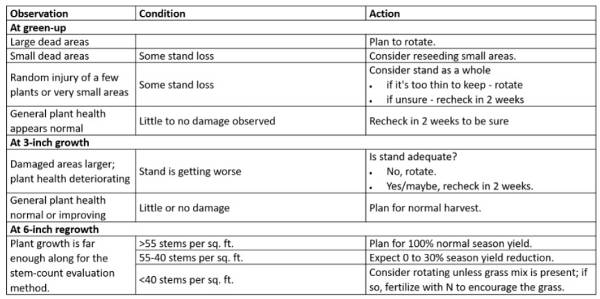- Cold temperature exposure. In some cases, the crown/upper taproot could not tolerate exposure to cold temperatures. Alfalfa tolerance to winter is complicated, as discussed in an earlier ICM News article, “Alfalfa Winter Survival - A Complicated Subject”. Several factors typically contribute to stand loss. Very wet fall soil conditions contribute to alfalfa not hardening-down as well as usual into the winter. Consequently, the alfalfa’s cold-tolerance is a bit less than normal. Additional stresses may seem minor, but they can make a significant difference when combined together. Factors like variety winter survival rating and disease resistance, soil pH and fertility, age of stand (seedlings are more susceptible to heaving while older plants are more susceptible to cold injury), soil drainage, intensity of harvest schedule and stubble height in fall can all play a role in alfalfa winter survival
- Alfalfa stubble height in fall. While this factor doesn’t seem to make a difference much of the time, it is showing a strong pattern this spring. Many of the fields with winter-injury are fields without good fall stubble. Both cold injury to plants and heaving damage are more prevalent in fields that were cut short and late in the fall. This is the case for both young and older stands.
Managing alfalfa fields with winter injury
As fields continue to green-up and there are a few inches of growth, it will be much easier to assess stands and determine what course of action needs to be taken whether that’s potentially doing some patch-work seeding, keeping the field for a first crop cutting then rotating, or just rotating fields entirely.
Evaluate each field as soon as possible this spring. Table 1 and Table 2 can be used to help determine what type of action may be warranted in a field.
Table 1. Suggested plans of action based on observations and alfalfa field conditions.

Table 2. Recommended plant counts per square foot in either pure alfalfa or alfalfa-grass mix based on the age of the stand.

Overwintering perennial forage grasses often survive better than winter hardy legumes. However, orchardgrass and ryegrasses are more susceptible than other perennial forage grasses to winter injury. Visual evaluation of grass regrowth and vitality of crown tissue is suggested when evaluating winter survival of pastures.
Reseeding in hayfields or pastures might be needed. It is not recommended to reseed alfalfa into stands that are two years or older due to the likelihood of autotoxicity. Overseeding or drilling grasses or red clover into thin or winter damaged stands should be done before May 1. Seeding after mid-May increases the likelihood seeds will germinate but less frequent rainfall will allow the soil to dry out before roots are deep enough to reach moist soil, killing the seedlings.
Source: iastate.edu